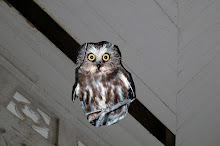I fixed these two issues during my remedial fleece washing. I purchased detergent. And I heated up water on the stove to add to the stuff that comes out of the tap. Much better!
The next step in turning raw wool into something wearable is to card it. There are lots of videos if you are fascinated by this sort of thing (Google "hand carding"), but here I present photos of White Wool on Red Picnic Table. This is mostly because I just painted the picnic table and want it to get some blog time.
Part, the first: Load hand cards with some raw wool:


Brush the wool back and forth between the two cards until it's all smooth and fluffy. This is what it looks like after the first transfer:

See the hay? We call that VM (vegetable matter). When you're satisfied, roll the wool off the card. Here is the carded rolag next to some raw fleece.

(Can you believe that Firefox's spell check doesn't recognize the word "rolag?")
When you have a bunch of rolags, head to the wheel and start spinning! I sampled a bunch of different ways of spinning the fleece. To the left is fluffy long draw (woolen), and to the right is a smooth, squishy short draw which is chain plied. Chain plying is a crazy Escher-like technique that boggles Bill's brain, and results in a single strand of wool becoming three-ply.

Spinning has taught me that a fiber can change so much from it's initial form to yarn and then again to a knitted fabric. So, before I decided what I liked best, I knitted up my samples. Look at all the wooly goodness here...fiber, yarn and swatch:


All the samples. Labeled, natch: (really, Firefox? You recognize "natch" is a word, but not "rolag?!?")

I'm adding to yarn for my sweater vest too. Just one more yarn to go and then I'll start knitting.


Finally...I've been stockpiling fiber for the Tour de Fleece. More on that soon!




















